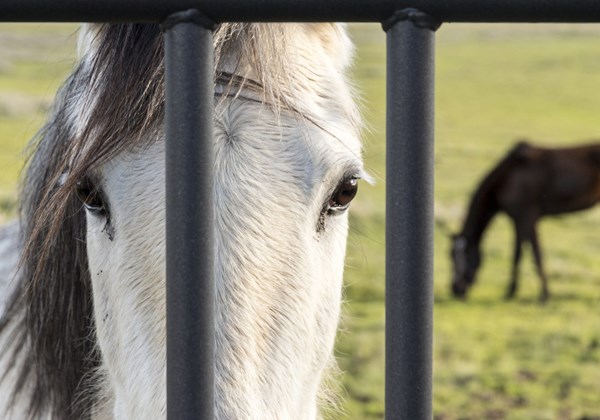 Credit: Thinkstock
Credit: ThinkstockDoes your horse have a lump or a bump? In veterinary school, students are taught the phrase “A lump is a lump and a bump is a bump, until you biopsy it!” All this means is that you cannot tell what a bump is just by looking at it. A bump could be an abscess, a benign growth or a more serious tumor. Certain things about the appearance, location or behavior of a lump or a bump can give your veterinarian clues towards a possible diagnosis and the best treatment, but until you actually submit the tissue for analysis, they are unable say for sure!
Depending on the location, appearance or behavior of your horse’s lump or bump, your veterinarian could follow a few different courses of action. The first is to “wait and see.” For a small bump in an area where it is not bothering the horse, you can often just watch and make sure it does not start to increase in size or irritate the horse. The second is to biopsy the lump to diagnose what it is and decide on the best course of treatment based on the type of tissue you find. There are many ways to biopsy a lump from sticking a needle into the mass and aspirating cells, or cutting a piece of tissue from the side of the bump. Finally, for certain lumps in certain locations, the whole bump can be removed and then analyzed for what type of tissue it is, and if any tissue was left behind.
The three most common types of lumps/bumps a horse will get are sarcoids, squamous cell carcinoma or melanomas. Melanomas are most commonly seen in gray horses. There are as many different ways to treat each of these conditions as there are horses in Kentucky and each method has a different success rate. Unfortunately, no method has a 100% success rate.
Sarcoids are probably the most common lump that appears on a horse. They can have a varied appearance and will show up as anything from a hairless area of skin to a big multi?lobed ulcerated mass. They can show up anywhere on the body. Depending on where it is on the body and what it looks like, a sarcoid can be treated with a “wait and see” approach, surgical removal, cryotherapy (where we freeze the sarcoid tissue to death), or injections of either an immune stimulating substance or a chemotherapeutic drug. Some veterinarians prefer to use combination therapy on sarcoids and apply multiple treatments at once to a single lump. Sarcoids have a bad habit of recurring and can come back bigger and stronger than before they were disturbed–which is why we will often “wait and see” with these particular lumps.
Squamous cell carcinoma is seen more often in warm, sunny areas and often shows up on non-pigmented skin like pink third eyelids, white eyelids or sheaths. These lumps will often first appear as just a slightly ulcerated area and some owners mistake the sites for fly bites or scratches at first. These are treated with similar methods as sarcoids, with the exception that we do not wait and see what a squamous cell lump does! Most veterinarians will treat these with combination therapy such as surgical removal and injection with a chemotherapeutic to help prevent recurrence.
Finally, melanomas are those big bumps we often see on the tails or around the throat latch of gray horses. Often times they are benign, and do not cause the horse too much trouble so we can just keep an eye on them. Ones that are bothersome to the horse are again treated with either removal or injection. The problem with the melanomas that occur around the throat latch is that they are surrounded by all sorts of important structures like the carotid artery, the jugular vein and the nerves that help control breathing and no one wants to mess with these in surgery if it is not necessary! A vaccine has recently been developed in dogs that has been tested in horses (it is not cheap), but it has shown some promise in causing melanomas to regress or prevent their progression.
Recently, I removed a lump on a horse’s neck at Hagyard’s Davidson Surgery Center. “Blue” had been referred in by an excellent local veterinarian who had already biopsied the bump and recommended removal based on the results. “Blue” was sedated and restrained in a set of stocks so the procedure could be performed standing.
For minor procedures like this lump removal, it is nice to use local blocks and avoid having to put the horse under general anesthesia.
I was able to ultrasound the area to assess how far the abnormal tissue extended. Then, the area was cleaned and prepared for sterile surgery.
The lump was easily removed and the remaining area sutured closed.
“Blue” was a great patient and his surgical site has since healed up well. The entire lump was submitted and showed that all of the abnormal tissue was removed with clean margins. The owner will continue to keep an eye on the site for any recurrence but otherwise, “Blue” is ready to get back to being a happy, healthy, bump-free horse.
This article was written by Hagyard Equine Medical Institute’s Liz Barrett, DVM, MS, DACVS.


